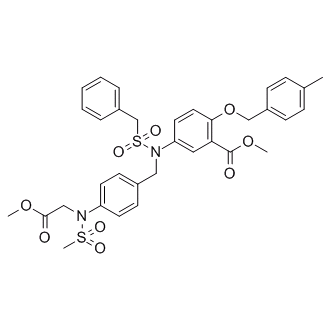| Cas No.: | 1919853-46-5 |
| Synonyms: | PTP1B-IN-2,PTP1B inhibitor 2 |
| SMILES: | CC1=CC=C(C=C1)COC2=C(C=C(C=C2)N(CC3=CC=C(C=C3)N(CC(=O)OC)S(=O)(=O)C)S(=O)(=O)CC4=CC=CC=C4)C(=O)OC |
| Formula: | C34H36N2O9S2 |
| M.Wt: | 680.78 |
| Purity: | >98% |
| Sotrage: | 2 years -20°C Powder, 2 weeks 4°C in DMSO, 6 months -80°C in DMSO |
| Description: | PTP1B-IN-2 is a potent protein tyrosine phosphatase 1B (PTP1B) inhibitor with an IC50 of 50 nM. |
| Target: | IC50: 50 nM (PTP1B)[1] |
| In Vitro: | PTP1B-IN-2 displays more than 40-fold selectivity for PTP1B over SHP-2 and LAR and 15-fold higher selectivity for PTP1B over the highly homologous TCPTP. PTP1B-IN-2 extends deep into the active site pocket, forming several hydrogen bonds and hydrophobic interactions with key residues of the catalytic site. The binding characteristics between PTP1B domain and ligand shows that PTP1B-IN-2 is an ABC type inhibitor which not only interacted with catalytic site but also B site and C site. PTP1B-IN-2 greatly enhances insulin-mediated IRβ phosphorylation at concentrations of 15 µM and 30 µM. Insulin-stimulated glucose uptake is also significantly increased in L6 myotubes treated with PTP1B-IN-2, and this increase is 16.0%, 19.0% and 38.1% at 5, 10 and 20 µM, respectively [1]. |
| Kinase Assay: | PTP1B-IN-2 is predispensed in 96-well microplates as 1.0 µL aliquots per well in 100% DMSO. The PTP1B enzymatic assay is carried out in a total volume of 100 µL per well in assay plates with 15 nM recombinant PTP1B protein, 2 mM p-nitrophenylphosphonic acid (pNPP), 1 mM dithiothreitol and 1 mM EDTA (pH 6.5). After 30 min incubation at 37oC, the reaction is terminated by addition of 2.5 M NaOH. The amount of hydrolysis product, pNP, is monitored by detection of the absorbance at 405 nm[1]. |
| References: | [1]. Liu P, et al. Discovery of novel, high potent, ABC type PTP1B inhibitors with TCPTP selectivity and cellular activity. Eur J Med Chem. 2016 Aug 8;118:27-33. |

 DC Chemicals' products qualify for U.S. tariff exemptions. We guarantee no price increases due to customs duties and maintain stable supply, continuing to deliver reliable research solutions to our American clients.
DC Chemicals' products qualify for U.S. tariff exemptions. We guarantee no price increases due to customs duties and maintain stable supply, continuing to deliver reliable research solutions to our American clients.





















